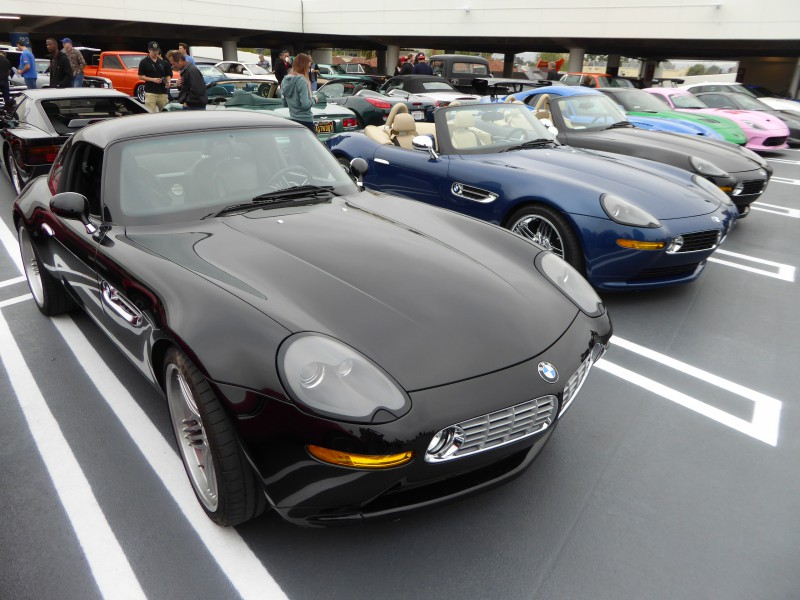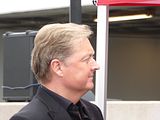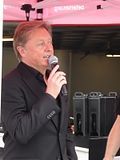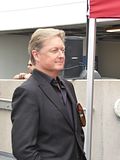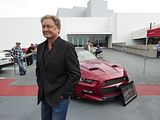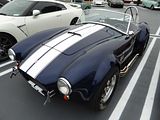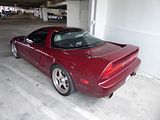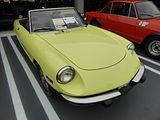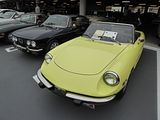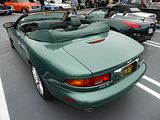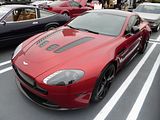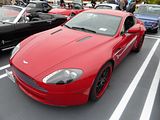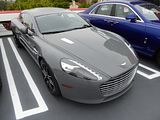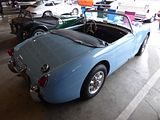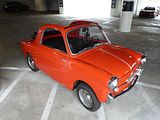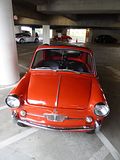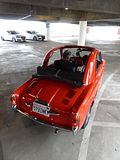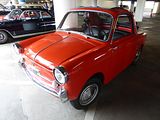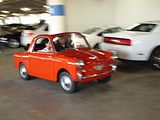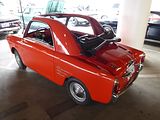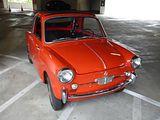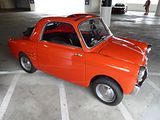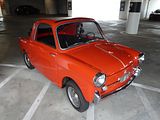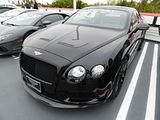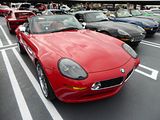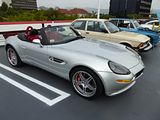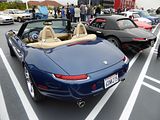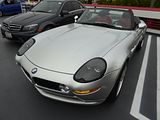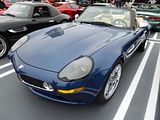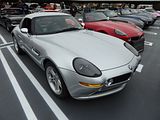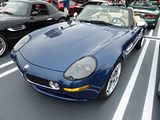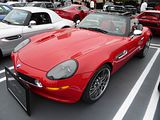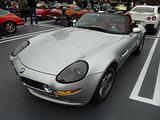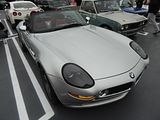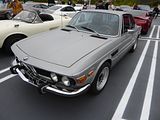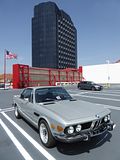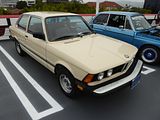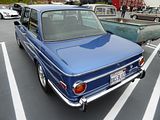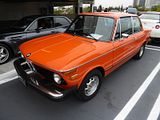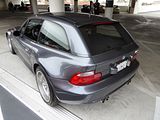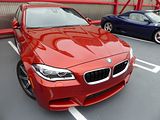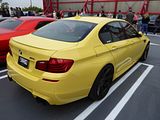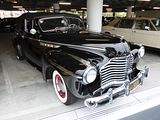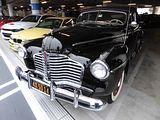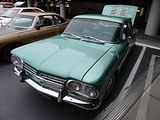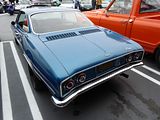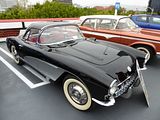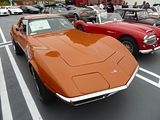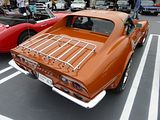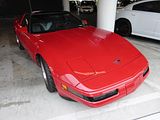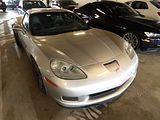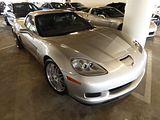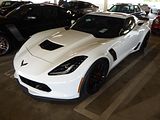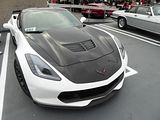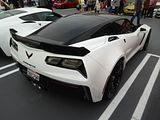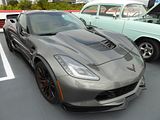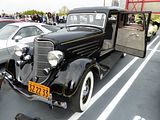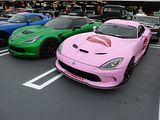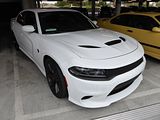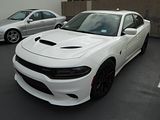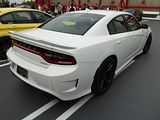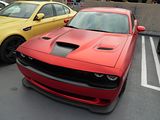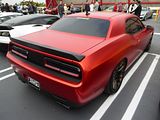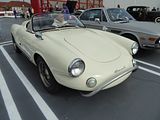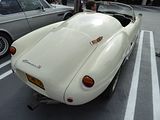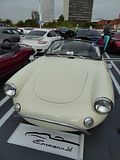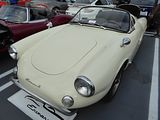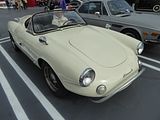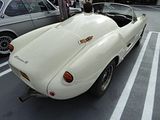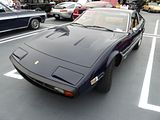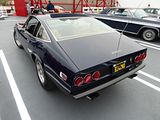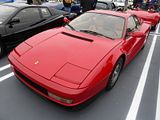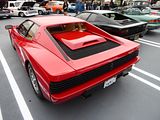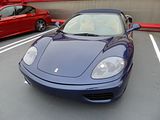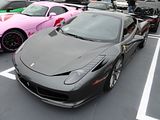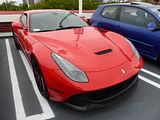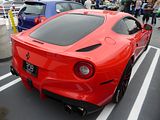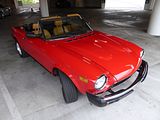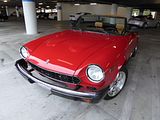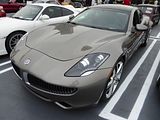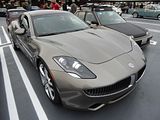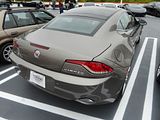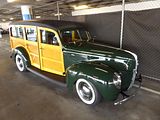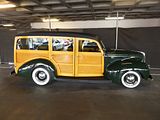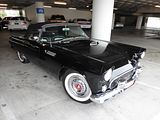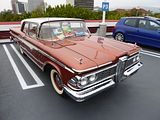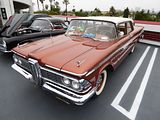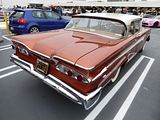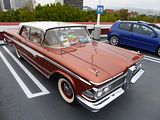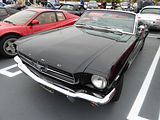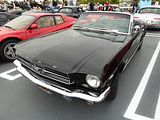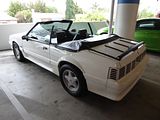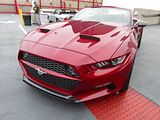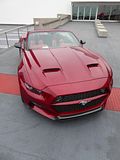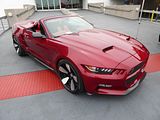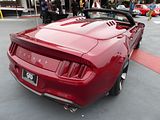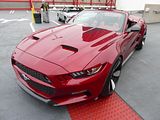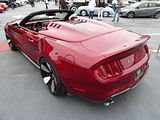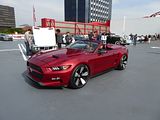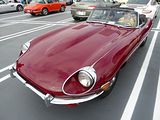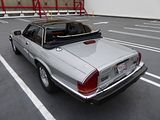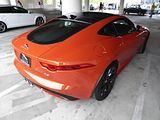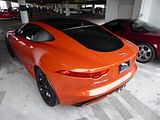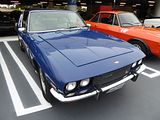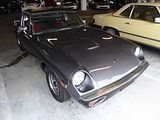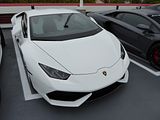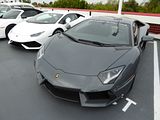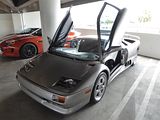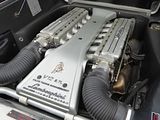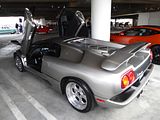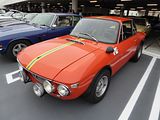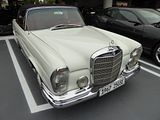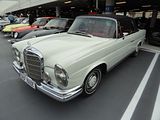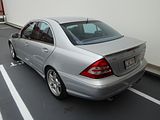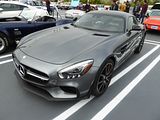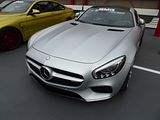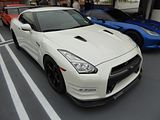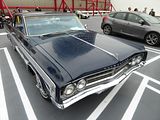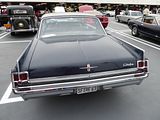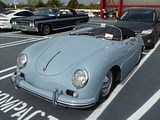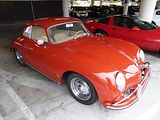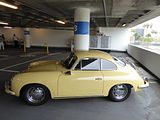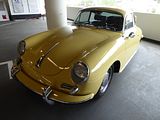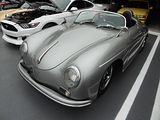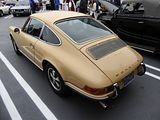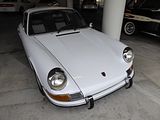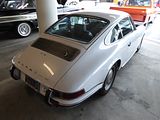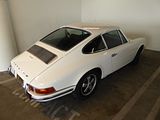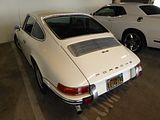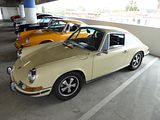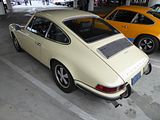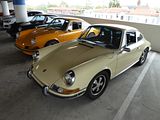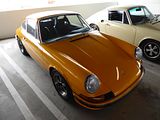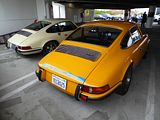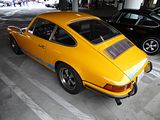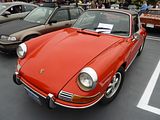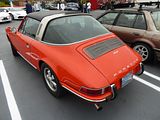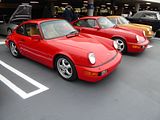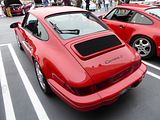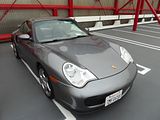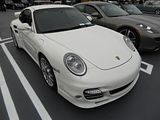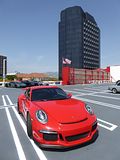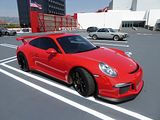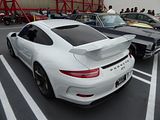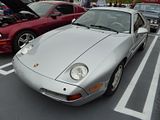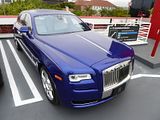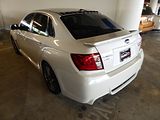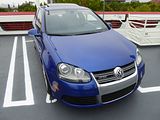Like many, I was very disappointed to learn that what is widely believed to have been the very first “Cars and Coffee” event, the one held every Saturday morning in Irvine in Orange County in Southern California had been cancelled permanently from December 2014, as I had enjoyed attending when I was on one of my trips to this part of America. Judicious use of Google suggested that there were indeed a number of events that sprung up in its place, but there seemed to be difficulties with some of the venues, so throughout 2015, I failed to find anything to attend. And it looked like that would continue into 2016, until I was alerted, by a friend who has never even been to Southern California, to the fact that there was going to be a gathering at the renowned Petersen Museum which would feature famous designer Henrik Fisker and some of the cars for which he had been responsible. Further research revealed that this would be part of what you might call a “Cars and Coffee” or a “Breakfast Club”, but which the Petersen were calling a “Cruise In”. So in fact these early morning weekend gatherings had been going on for some time, only a short journey from my hotel, completely unbeknown to me. I needed to go and investigate. My rental car was certainly one of those which would need to stay in general parking (it was a Hyundai Sonata!), but that’s no problem, as you simply use a different part of the parking structure from the open-topped area where the display cars gather. The day started somewhat murky. as is often the case in Los Angeles, when the city is engulfed in low cloud, until the sun can burn it off, which it did, but only after most of the cars had gone, but that was no deterrent to those who wanted to bring their treasured possessions or indeed a couple of local dealers who had some high end new cars on show. It proved to be an interesting morning, which I extended by then going to have a look at the recently revamped museum. Here are the cars which “cruised in”.
ABARTH
Strictly speaking, this should perhaps be categorised under Fiat, as in America, Abarth is a model version rather than a brand. The car is different to those seen in Europe, with US crash regulations requiring a slightly different front end as well as detailed differences such as the side reflectors. Mechanically, all US Abarth models have a 160 bhp Multi Air engine as opposed to the T-Jet unit used for the Polish-built cars that have varying power outputs. Trim and equipment levels are different, too.
AC
Although we tend to think of the AC Cobra as British, the reality is that it was conceived by Carroll Shelby, an American, who in the early 1960s operated only a few miles away from this venue near the airport. Replica Cobra models, like this one, are just as popular here as they are in the UK and this was one such example.
ACURA
Here’s one I have put under its US branding. We all thought of the NS-X as a Honda, but to American buyers, the car was sold through the Acura network instead.
ALFA ROMEO
From the 105 Series of cars were this duo of 1750 Spider and GTV
ASTON MARTIN
DB7 Volante
From the current catalogue were a number of dealer-supplied cars, a V12 Vantage S and V8 Vantage and a Rapide S
AUSTIN-HEALEY
There was a nice example of the “Big Healey”, the 3000, here, proving that although lots of them have in recent years been re-imported back to the UK but that there are still some here where the car was popular when new. Donald Healey had been producing a range of expensive sports cars from the 1940s, cars such as the Silverstone, the Abbott and the Farnham. For the 1952 London Motor Show, he produced a new design, which was called the Healey Hundred, based on Austin A90 mechanicals, which he intended to produce in-house at his small car company in Warwick. It was one of the stars of the 1952 Show, and it so impressed Leonard Lord, the Managing Director of Austin, who was looking for a replacement to the unsuccessful A90. that Lord struck a deal with Healey on the spot, to build it in quantity. Bodies made by Jensen Motors would be given Austin mechanical components at Austin’s Longbridge factory. The car was renamed the Austin-Healey 100, in reference to the fact that the car had a top speed of 100 mph. Production got under way in 1953, with Austin-Healey 100s being finished at Austin’s Longbridge plant alongside the A90 and based on fully trimmed and painted body/chassis units produced by Jensen in West Bromwich—in an arrangement the two companies previously had explored with the Austin A40 Sports. By early 1956, production was running at 200 cars a month, 150 of which were being sold in California. Between 1953 and 1956, 14,634 Austin-Healey 100s were produced, the vast majority of them, as was the case for most cars in this post war era, going for export. The car was replaced by an updated model in 1956, called the 100-6. It had a longer wheelbase, redesigned bodywork with an oval shaped grille, a fixed windscreen and two occasional seats added (which in 1958 became an option with the introduction of the two-seat BN6 produced in parallel with the 2+2 BN4), and the engine was replaced by one based on the six-cylinder BMC C-Series engine. In 1959, the engine capacity was increased from 2.6 to 2.9 litres and the car renamed the Austin-Healey 3000. Both 2-seat and 2+2 variants were offered. It continued in this form until production ceased in late 1967. The Big Healey, as the car became known after the 1958 launch of the much smaller Austin-Healey Sprite, is a popular classic now.
There was also an example of its smaller brother, the Sprite. In the UK it is known affectionately as the “Frog Eye” whereas the Americans call it the “Bug Eye”.
AUTOBIANCHI
I was somewhat surprise when I saw this car drive in, a 1959 Bianchina. Had this been Italy, then yes, seeing one would be perhaps on the cards, but not here in California. Needless to say, the smallest car there often had one of the largest crowds around it. This tiny car was based on the Fiat 500 and was available in various configurations: Berlina (saloon), Cabriolet (roadster), Trasformabile (convertible), Panoramica (station wagon), and Furgoncino (van). The car was presented to the public on 16 September 1957 at the Museum of Science and Technology in Milan. Initially, the car was equipped with the smallest Fiat engine, air-cooled 479 cc producing 15 PS. In 1959, the engine power was increased to 17 PS and in 1960, the cabriolet version was launched. In the same year, the Trasformabile, whose engine cylinder capacity was increased to 499 cc (18 hp), was made available in a Special version with bicolour paint and an engine enhanced to 21 PS. The Transformabile featured fixed B-pillar and partial roof, as the rest of the opening was covered with the foldable fabric hood. The Cabriolet version had no B-pillar. Also this was the only version to feature suicide doors. In 1962, the Trasformabile was replaced by a four-seat saloon. The engine and chassis were the same as in the Trasformabile. In 1965, a minor facelift was made. In France, the models were sold under different names: the Berlina became the Lutèce, the Familiare the Texane, and the Trasformabile was marketed as the Eden Roc. Around 275,000 were made right up to 1970, over half of them the Panoramica versions.
BENTLEY
One of the brand new cars on show was the latest Continental GT Coupe.
BMW and ALPINA
Guest of honour Henrik Fisker was responsible for designing the BMW Z8, and he was to be seen for much of the morning with the owners of the several examples of this classic that turned up, all of whom clearly wanted not just to talk to him, but to get photos of him with their cars, and he was given the almost invidious task of selecting one of them as “Car of the Day”. Originally presented as a concept, the Z07, a styling exercise intended to evoke and celebrate the 1956-’59 BMW 507 and to celebrate the millennium change, the car was a sensation at the ’97 Tokyo Auto Show and its overwhelming popularity spurred BMW’s decision to produce a limited production model. Fortunately, the Z07 had been designed with production in mind. As a result, practical and regulatory considerations necessitated very few changes for the production model. Nevertheless, the windscreen of the Z8 was extended upward, and a larger front airdam was fitted. Both changes were implemented to provide aerodynamic stability and a reasonably placid cockpit environment. The four-spoke steering wheel of the concept car was replaced by a three spoke design. The hardtop was changed from a double-bubble form with a tapering faring to a single dome with a truncated convex backside. The concept’s exotic driver’s side helmet fairing was eliminated to allow easy operation of the power soft top. Despite these changes, the Z8 remained extremely faithful to the concept car. The side-mounted indicators were integrated into the side vents in a fashion that rendered them invisible until activated. The vintage simplicity of the interior was preserved by hiding the modern equipment under retracting panels. Complex compound curves were preserved through the use of an expensive MIG-welded aluminium space frame. The Z8 even retained the concept’s five-spoke wheel design, albeit without the race-style centre lug nut. The Z8’s spaceframe was produced in the Dingolfing Plant and the car hand-finished in Munich. It had an all-aluminium chassis and body and used a 4941 cc 32-valve V8, that developed 400 hp and 370 lb·ft (500 N·m) torque. This engine, known internally as the S62, was built by the BMW Motorsport subsidiary and was shared with the E39 M5. The engine was located behind the front axle in order to provide the car with 50/50 weight distribution. The factory claimed a 0–100 km/h (0–62 mph) time of 4.7 seconds; Although it could outperform a Ferrari 360 Modena in several respects, as with most BMW products, its top speed was electronically limited to 155 mph (250 km/h). The Z8 used neon exterior lighting, the tail lights and indicators are powered by neon tubes that offer quicker activation than standard lightbulbs and expected to last for the life of the vehicle. The Z8’s head and tail lights were done by Vipin Madhani. Every Z8 was shipped with a colour-matching metal hardtop. Unlike many accessory hardtops, which are provided for practical rather than stylistic considerations, the Z8 hardtop was designed from the outset to complement the lines of the roadster. In order to promote the Z8 to collectors and reinforce media speculation about the Z8’s “instant classic” potential, BMW promised that a 50-year stockpile of spare parts would be maintained in order to support the Z8 fleet. Due to the limited volume of Z8 production, all elements of the car were constructed or finished by hand, thereby compounding the importance of ongoing manufacturer support for the type. The price point and production process allowed BMW to offer custom options to interested buyers. A significant number of Z8s with non-standard paint and interior treatments were produced over the course of the four-year production run by BMW Individual. 5,703 Z8s were built.
With production of the Z8 completed by November 2002, for 2003 the Z8 production was replaced by the Alpina V8 Roadster. The Alpina was a departure from the hard-edged sporting focus of the original car, and elements of the new grand touring intent were evident throughout this final edition. Instead of the original six-speed manual and 4.9 litre S62 engine featured in earlier Z8’s, the Alpina came only as an automatic, using a five-speed BMW Steptronic transmission allied to a downgraded 4.8 litre Alpina-tuned V8 motor from the Alpina E39 B10 V8 S (M62). In order to complete the car’s transition from sportscar to boulevardier, relaxed suspension tuning was used. The standard Z8’s run-flat tyres on 18 in wheels were discarded in favour of conventional tires with softer sidewalls, on 20 in wheels. A new, softer grade of Nappa leather replaced the Z8’s less supple specification, and special Alpina gauges were featured on the dash cluster. An Alpina steering wheel with three solid spokes replaced the original, which could not be retrofitted with shift paddles for the automatic. Gear selection was displayed in an Alpina-specific display mounted in front of the wheel. Performance of the Alpina V8 differed from that of the standard car in that peak power was reduced to 375 hp while peak torque was raised to 383 lb·ft; this torque was available at significantly lower rpm than the original in order to enable more relaxed cruising. Curiously, the electronically limited top speed was officially raised to 161 mph. Only 555 of these Alpinas were built, 450 of which were exported to the US market and only eight to the UK. In the United States, this special edition of the Z8 was sold directly through BMW dealerships, marking a first for Alpina, whose cars had never been sold through retail channels in the US. There was one Alpina here along with the other Z8 models.
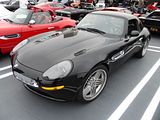
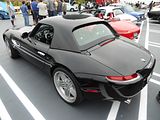
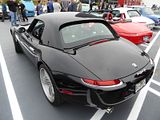
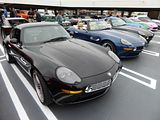
.
First of the classic BMWs I came across was this E9 3.0 CS. Known internally as the E9, this two-door coupé was built for BMW by Karmann from 1968 to 1975. It was developed from the New Class-based BMW 2000 CS coupé, with the wheelbase and length increased to allow the engine bay to be long enough to accommodate the new 2788cc 170 hp straight-six engine code-named M30, and the front of the car was restyled to resemble the E3 saloon. The rear axle, however, remained the same as that used in the lesser “Neue Klasse” models and the rear brakes were initially drums – meaning that the 2800 saloon was a better performing car, as it was also lighter. The CS’ advantages were thus strictly optical to begin with, though as the 2800 CS was lighter than the preceding 2000 CS and it had a smaller frontal aspect, so it did perform far better than its predecessor. The 2800CS was replaced by the 3.0 CS and 3.0 CSi in 1971. The engine had been bored out to give a displacement of 2,986 cc , and with twin carburettors produced 180 hp in the 3.0 CS or with Bosch D-Jetronic fuel injection, 200 hp in the 3.0 CSi. There was a 4 speed manual and an automatic transmission variant. They were sold in the United States from 1970 to 1974, by Max Hoffman. He was the importer and sole distributor for BMW from the mid-sixties until selling his business to BMW of North America in 1975. 1974 model cars had protruding 5 mile per hour bumpers. The model was replaced by the 6 Series in 1976.
Next up was an E21 320, the first of the line. Presented in July 1975, this was only available as a 2 door saloon, looking like a shrunken version of the E 12 5 Series which pre-dated it by 3 years. The first cars came with either a 1.6 or 2 litre four cylinder carburettor engine, with a fuel injected 2 litre, in the 320i arriving a few months later. The car was well received, but universally praised, as not only were the cars costly and very spartan, but the rear suspension was capable of catching the unwary out (these days the journalists would praise this, but not in the mid 70s). Visually little changed over the next 6 years, though in late 1977 the 320 received the M20 six cylinder engine and the top of the range received a larger 2.3 litre unit. Baur produced open-topped cabrio versions in small quantities. 1,364,039 examples were produced before the E30 model arrived to replace it in early 1982.
There were a couple of examples of the pre-cursor to the 3 Series here as well., 02 cars, as they are known. These were produced from 1967 to 1976, overlapping its replacement for a few months. Effectively a shortened version of the “Neue Klasse” 4 door saloon model that started out as the 1500 in 1961, the more agile 2 door 1600 quickly found favour, a status which was boosted when BMW put a 2 litre engine under the bonnet and fuel injected it to give the car, the 2002 ti, a sparkling performance. The less potent models were not quite so much fun, of course, and they were fearsomely expensive (and spartan) compared to their rivals, but still found favour among discerning buyers who liked the engineering quality and road manners of these cars. Seen here were an early 2002 and a late model 2002 tii somewhat disfigured by the ungainly impact-absorbing bumpers that had to be fitted to all US market cars in the mid 1970s.
A more recent classic was this M Coupe, the combination of M3 engine and BMW’s small sports car. This has the body of the closed version of BMW’s first “affordable” open two seater sports car, and first BMW model to be manufactured in the United States. In E number speak, it was coded the E36/7, for the roadster variant which was first to market, being introduced in 1995, and E36/8 refers to the coupe variant which was released in 1999. The Z, as used for the earlier Z1, and later Z4 and Z8 models stands for Zukunft, German for “future”. The BMW Z3 was introduced via video press release by BMW North America on June 12, 1995 and made a short appearance in the James Bond film GoldenEye on November 17, 1995. Karen Sortito was responsible for the campaign, and sales of the Z3 spiked as the film sat at number one at the Box Office. In the 1996 production run, more than 15,000 roadsters were sold by the time the car was introduced. Initially it was offered with a 1.9 litre 4 cylinder engine, though a 2.8 litre V6 unit soon joined it. Additional engine choices came along during the model’s lifetime, of which the one which got the enthusiasts most interested was when the 3.2 litre unit from the M3 was squeezed under the bonnet to create a car which was officially known as the M Roadster, though many refer to it as the Z3M. There were some visual differences as well, including a more aerodynamic front bumper with no fog lights, a rear bumper designed to fit quad exhausts, temperature and oil gauges in the centre console, an M sports steering wheel and gear lever, M seats and 17-inch M wheels. Outside mirrors also have a more aerodynamic design. The front gills on Z3M models are different as well, with a chrome strip running through them. Z3M models did not share cosmetic changes from the facelift, but they had and bigger brakes. In 2000, the S52 engine replaced the S50 and this was updated again with the S54 engine installed in the 2001 and 2002 model year vehicles. The Coupe version was mechanically the same as the Roadster and was added to the range in mid 1999. This model was fearsomely expensive when new and hence sold in tiny quantities. BMW did in due course offer the Coupe body, with its unusual breadvan styling with less powerful engines, but only the 6 cylinder units. A facelift for the range was introduced in 2000, and the Z3 ended production in 2002 when it was replaced by the BMW Z4.
Rounding things off for BMW was a dealer-supplied version of the still-current M5
BUICK
1941 Eight
CHEVROLET
Plenty has been written about this duo of cars, a Corvair Sedan and a second generation Corvair Coupe, following the publication of consumerist Ralph Nader’s book “Unsafe at any Speed”, even though subsequent research found that the car was no more prone to the things which the non-driving Nader alleged than many others on sale at the same time. Although the book damaged sales, that was not the only reason why the car ultimately was not that commercially successful. Until 1960, the “Big Three” domestic auto manufacturers (General Motors, Ford, and Chrysler) produced only one basic size of passenger cars: large. However, a successful modern “compact car” market segment was established in the US by the 1950 Nash Rambler. Moreover, imports from Europe, such as Volkswagen, Renault, and Fiat, showed that there was demand in the US for small cars, often as a second car or an alternative for budget-minded consumers. While the “Big Three” continued to introduce ever-larger cars during the 1950s, the newly formed American Motors Corporation (AMC) focused its business strategy on smaller-sized and fuel-efficient cars, years before there was a real need for them. The sale success of the Rambler did not go unnoticed, so during 1959 and 1960, the Big Three automakers planned to introduce their own “compact” cars. Most of these designs were scaled-down versions of the conventional American car, using four- or six-cylinder engines instead of V8s, and with bodies about 20% smaller than their standard cars. The exception to this was going to be Chevrolet’s offering, the Corvair. Led by General Manager Cole, Chevrolet designed a revolutionary new car. It was powered by an air-cooled horizontal six-cylinder 2.3 litre engine made almost entirely out of aluminium, which initially produced 80 bhp. The engine was mounted in the rear of the car, driving the rear wheels through a compact transaxle. Suspension was independent at all four wheels. There was no conventional frame, it was the first unibody built by Fisher Body. The tyres were an entirely new wide low-profile design. The styling was unconventional for Detroit: subtle and elegant, with no tailfins or chrome grille. Its engineering earned numerous patents, while Time magazine put Ed Cole and the Corvair on the cover, and Motor Trend named the Corvair as the 1960 “Car of the Year”. As well as a four door saloon, the range included a two door coupe, a convertible, and from 1961, an estate car as well as a range of light commercial vehicles including a panel van and a pick up. The Corvair’s sales exceeded 200,000 for each of its first six model years. Sales figures revealed to Chevrolet management that the Corvair was more of a specialty car than a competitor to the conventionally designed Ford Falcon or Chrysler’s Valiant. Corvair was not as competitive in the economy segment and Chevrolet began a design program that resulted in a compact car with a conventional layout, the Chevy II, for the 1962 model year. That meant that the Corvair was developed in a different way, with more emphasis put on the sporting models. so in 1962 a high performance 150 hp turbocharged “Spyder” option was added for the Monza coupes and convertibles, making the Corvair the second production automobile to come with a turbocharger as a factory option The Monza Coupe was the most popular model with 151,738 produced out of 292,531 total Corvair passenger car production for 1962. The Corvair was fast becoming the darling of the sporty car crowd. Many after-market companies offered a vast array of accessories for the Corvair, everything from imitation front grilles to serious performance upgrades such as additional carburettors, superchargers and performance exhaust and suspension upgrades. There were numerous detailed changes for 1963 and 1964. The Monza line really came into its own, as in 1963, 80% of sales were Monzas. The Convertible model counted for over 20% of all the Monzas sold. A sporty image meant big profits. In October 1964, Chevrolet presented a new Corvair, with different styling and detailed refinements to the mechanical parts, as well as fully independent rear suspension replacing the former swing axles. Saloon, coupe and convertibles were the only body styles offered, the other versions having been not renewed. Although the new car received rave reviews from journalists such as the often-critical David E Davies, sales were not that strong, and they declined every year thereafter. By 1967, the range was pruned to just the 500 and Monza Hardtop Coupes and Hardtop Sedans, and the Monza Convertible. Chevrolet was still actively marketing the Corvair in 1967, including colour print ads and an “I Love My Corvair” bumper sticker campaign by dealers, but production and sales continued to fall off drastically. Only 27,253 copies were built. In 1968, the four-door hardtop was discontinued, leaving three models—the 500 and Monza Hardtop Coupes and the Monza Convertible. All advertising was virtually stopped and sales were down to 15,400. The final model-year 1969 Corvairs were assembled almost by hand at the same plant as the Nova in Willow Run, Michigan. A total of 1,786,243 Corvairs were produced between 1960 and 1969. The phenomenal success of the Ford Mustang and that 1966 book had proved very damaging to the Corvair, and GM decided that their sporting future lay with the Camaro and for families, with the Nova. These days, there is something of a cult-following for the Corvair.
The Corvette was well represented, with examples of almost every one of the 7 generations produced since 1963. As well as a nice 1st generation model, there was a late 60s Corvette Stingray, a C4 from the late 1980s, a C6 Hardtop and a trio of the current C7 Z06 models.
DODGE
This 1934 Dodge de Luxe Six was a rather splendid machine, and there was some added interest from the display with two gents dressed up as bank robbers
There were a couple of rather vividly painted SRT-10 Coupe models here, the latest of the Viper series of cars.
Sitting at the top of their respective ranges are the Hellcat versions of both the Charger and the Challenger. Although they do not look that different from the cooking versions of these models, there is a full 707 bhp available from the 6.3 litre V8 engine under the bonnet, making these rather rapid.
ENZMANN
Perhaps the rarest car of the day, and certainly the one which fewest could recognise was this, an Enzmann 506. I certainly had no idea what it is, and even when its identity was revealed, was not much the wiser. That happened as it was selected for one of the awards of the day, which caused me then to go back and have a closer look at what I had assumed was a kit car. I had quite a chat with the owner and learned more about it. The Enzmann was introduced in 1957 and was available until the late 1960s, perhaps as late as 1969. Named after the number of the stand on which it was displayed at the Frankfurt Show when it made its debut, the car was made in Switzerland. Enzmann bought regular VW Beetles, took the body off and put on the one piece GRP unit as seen here. The company had made their name in the boat-building business and applied their expertise in working with fibreglass to create the new car, which stood just 3 foot tall. As the contemporary Porsche 356 was based on a Beetle design, some of the cars had Porsche 356 mechanicals instead, which gave them far more power than 30 bhp of the Beetle engined cars. At 1102 lbs, it was considerably lighter than either the Porsche or the 1650lbs VW which made it quite sprightly. There are no doors, so one of the unusual things about it is how you get in – something the owner demonstrated as he prepared to leave. There is cut-out in the side of the body which you put one foot into, then you pull your other foot over the low sides and a rest it on a moulded foot brace on the centre console as you swing your first leg over the low body sides and lower yourself into the moulded seats. The interior is far from luxurious, though it is sturdily constructed. In 1960, the convertible body, complete on your own chassis, cost $1430, plus $95 for mounting. For a complete Enzmann-Spider with a factory new frame, the cost was $1961. If you wanted a car with the folding all-weather top, special bucket-seats, convertible windscreen, heater, defroster, bumper and screen washers, you paid $2156. No-one is sure exactly how many were made, but it is believed the total was around 70, of which just 19 survive and this is the only one in the US.
FERRARI
The rarest of the Ferrari models on show was this 365 GTC/4. Replacing the earlier 365 GT 2+2, this was Pininfarina-designed car was a 2+2 grand tourer, based on the chassis of the 365 GTB/4 Daytona, produced only from 1971 to 1972, during which time 505 examples were made. Its chassis and drivetrain, however, were carried over mostly unaltered (apart from a wheelbase stretch to provide more rear seat room) on its successor, the 1972 365 GT4 2+2.. With its wedge shape, fastback silhouette, sharp creases and hidden headlamps the GTC/4’s styling clearly reflects the 365 GTB/4 “Daytona” it was based on. Power steering, electric windows and air conditioning were standard. The cabin was upholstered in mixed leather and tartan fabric, unique to this model and unusualyl for a Ferrari, with full leather upholstery an option. The 365 GTC/4 shared the chassis and engine block as the 365 GTB/4 Daytona, riding on the same wheelbase and suspension. Many changes were made to make it a more comfortable grand tourer than its two-seat predecessor and sibling. These included softer spring rate and a hydraulic power steering. The chassis was a tubular spaceframe, mated to a steel body with aluminium doors and bonnets; as was customary in this period, the bodies were made and finished by Pininfarina in Turin, then sent to Ferrari in Modena for the assembly. The suspension system used transverse A-arms, coil springs coaxial with the shock absorbers (double at the rear), and anti-roll bars on all four corners. Wheels were cast aluminium on Rudge knock-off hubs, while Borrani wire wheels were optional; the braking system used vented discs front and rear. The engine was a Tipo F 101 AC 000 Colombo V12, displacing 4,390 cc. Engine block and cylinder heads were aluminium alloy, with cast iron pressed-in sleeves; chain-driven two overhead camshafts per bank (four in total, as noted by the “4” in the model designation) commanded two valves per cylinder. The V12 was detuned to 340 bhp from the Daytona, to provide a more tractable response suited to a GT-oriented Ferrari. In place of the Daytona’s downdraft setup, six twin-choke side-draft Weber carburettors were used, whose lower profile made possible the car’s lower and sloping bonnet line. The 5-speed all-synchronised manual transmission was bolted to the engine, another difference from the Daytona which used a transaxle. The gearbox was rigidly connected to the alloy housing of the rear differential through a torque tube. Models for export to the United States were fitted with three-point seat belts, side markers and a number of engine modifications to comply with Federal emission standards, including air injection, carbon canister for evaporative emission control and a different exhaust system. On US-specification cars power was down to 320 bhp.
Object of many a poster on a young enthusiast’s bedroom wall when the car was new was the Testarossa and there was a nice example here. A replacement for the BB512i, the final iteration of Ferrari’s first ever mid-engined road car, the Testarossa was launched at the Paris Show in October 1984. The Pininfarina-designed car was produced until 1991, with the same basic design then going through two model revisions, with the 512 TR and later F512 M which were produced from 1992 to 1996 before the model was replaced by the front-engined 550 Maranello. Almost 10,000 Testarossas, 512 TRs, and F512 Ms were produced, making it one of the most-produced Ferrari models, despite its high price and exotic design. The Testarossa followed the same concept as the BB512, but was intended to fix some of the criticisms of the earlier car, such as a cabin that got increasingly hot from the indoor plumbing that ran between the front-mounted radiator and the midships-mounted engine and a lack of luggage space. This resulted in a car that was larger, and at 1,976 millimetres (78 in) wide the Testarossa was half a foot wider than the Boxer and immediately condemned for being too wide, though these days it does not appear anything like as wide as it did when new. This resulted in an increased wheelbase that stretched about 64 mm (2.5 in) to 2,550 mm (100 in) which was used to accommodate luggage in a carpeted storage space under the front forward-opening lid. The increase in length created extra storage space behind the seats in the cabin. Headroom was also increased with a roofline half an inch taller than the Boxer. The design came from Pininfarina with a team of designers led by design chief Leonardo Fioravanti, the designer of many contemporary Ferraris. The design was originated by Nicosia, but the guidance of Fioravanti was equally important. Being a trained aerodynamicist, Fioravanti applied his know-how to set the aerodynamics layout of the car. This meant the large side intakes were not only a statement of style but actually functional – they drew clean air to cool the side radiators and then went upward and left the car through the ventilation holes located at the engine lid and the tail. As a result, the Testarossa did not need a rear spoiler like Lamborghini’s Countach yet produced zero lift at its rear axle. The aerodynamic drag coefficient of 0.36 was also significantly better than the Lamborghini’s 0.42. Pininfarina’s body was a departure from the curvaceous boxer—one which caused some controversy. The side strakes sometimes referred to as “cheese graters” or “egg slicers,” that spanned from the doors to the rear wings were needed for rules in several countries outlawing large openings on cars. The Testarossa had twin radiators in the back with the engine instead of a single radiator up-front. In conjunction the strakes provided cool air to the rear-mounted side radiators, thus keeping the engine from overheating. The strakes also made the Testarossa wider at the rear than in the front, thus increasing stability and handling. One last unique addition to the new design was a single high mounted rear view mirror on the driver’s side. On US based cars, the mirror was lowered to a more normal placement in 1987 and quickly joined by a passenger side rear view mirror for the driver to be able to make safe easy lane changes. Like its predecessor, the Testarossa used double wishbone front and rear suspension systems. Ferrari improved traction by adding 10-inch-wide alloy rear wheels. The Testarossa drivetrain was also an evolution of the BB 512i. Its engine used near identical displacement and compression ratio, but unlike the BB 512i had four-valve cylinder heads that were finished in red. The capacity was 4,943 cc, in a flat-12 engine mid mounted. Each cylinder had four valves, lubricated via a dry sump system, and a compression ratio of 9.20:1. These combined to provide a maximum torque of 490 Nm (361 lb/ft) at 4500 rpm and a maximum power of 390 hp at 6300 rpm. That was enough to allow the Testarossa to accelerate from 0–60 mph in 5.2 seconds and on to 100 mph. The original Testarossa was re-engineered for 1992 and released as the 512 TR, at the Los Angeles Auto Show, effectively as a completely new car, with an improved weight distribution of 41% front: 59% rear. The F512 M was introduced at the 1994 Paris Auto Show, with the M standing for “modificata”. That car is easy to spot as it lost the pop-up headlights and gained awkward glazed in units.
It was with the 360 Modena that sales of Ferrari models really took off, with unprecedented volumes of the car being sold. The 360 Modena was launched in 1999, named after the town of Modena, the birthplace of Enzo Ferrari. A major innovation in this all new model came from Ferrari’s partnership with Alcoa which resulted in an entirely new all-aluminium space-frame chassis that was 40% stiffer than the F355 which had utilised steel. The design was 28% lighter despite a 10% increase in overall dimensions. Along with a lightweight frame the new Pininfarina body styling deviated from traditions of the previous decade’s sharp angles and flip-up headlights. The new V8 engine, common to all versions, was of 3.6 litre capacity with a flat plane crankshaft, titanium connecting rods and generates 400 bhp Despite what looks like on paper modest gains in reality the power to weight ratio was significantly improved on over the F355, this was due to the combination of both a lighter car and more power. The 0 to 100 km/h acceleration performance improved from 4.6 to 4.3 seconds. The first model to be rolled out was the 360 Modena, available as a manual, or an F1 electrohydraulic manual. Next up was an open car. The 360 was designed with a Spider variant in mind; since removing the roof of a coupe reduces the torsional rigidity, the 360 was built for strength in other areas. Ferrari designers strengthened the sills, stiffened the front of the floorpan and redesigned the windscreen frame. The rear bulkhead had to be stiffened to cut out engine noise from the cabin. The convertible’s necessary dynamic rigidity is provided by additional side reinforcements and a cross brace in front of the engine. Passenger safety is ensured by a strengthened windscreen frame and roll bars. The 360 Spider displays a curvilinear waistline. The fairings imply the start of a roof, and stable roll bars are embedded in these elevations. Due to use of light aluminium construction throughout, the Spider weighs in only 60 kg heavier than the coupé. As with the Modena version, its 3.6 litre V8 with 400 bhp is on display under a glass cover. The engine — confined in space by the convertible’s top’s storage area — acquires additional air supply through especially large side grills. The intake manifolds were moved toward the centre of the engine between the air supply conduits in the Spider engine compartment, as opposed to lying apart as with the Modena. In terms of performance, the 0-60 mph time was slightly slower at 4.4 seconds due to the slight weight increase, and the top speed was reduced from 189 to 180 mph. Despite the car’s mid-mounted V8 engine, the electrically operated top is able to stow into the compartment when not in use. The convertible top was available in black, blue, grey and beige. The transformation from a closed top to an open-air convertible is a two-stage folding-action that has been dubbed “a stunning 20 second mechanical symphony”. The interior of the Spider is identical to that of the coupé.
More recent cars were a 458 Italia and a F12 Berlinetta
FIAT
It was the American market which kept this car, called the Pininfarina Europa Spider in its final years, in production for quite so long. It started out as the 124 Spider, making its debut at the Turin Show in 1966, continuing in production until the mid 1980s. Early cars had 1400 and 1600cc engines, and these were gradually enlarged first 1800cc and then 2 litre, with fuel injection being added for more power and emissions compliance during the 1970s. Fiat spotted the potential of the car for more than just boulevard cruising, though, so in November 1972 they announced the Fiat Abarth 124 Rally, an overtly sporting version. Its main purpose was to receive FIA homologation in the special grand touring cars (Group 4) racing class, and replace the 1.6-litre Fiat Sport Spider rally car which had been campaigned. At the time, the 124 had already won the 1972 European Rally Championship at the hands of Raffaele Pinto and Gino Macaluso. The 124 Rally was added to the Sport Spider range, which included the 1600 and 1800 models; the first 500 examples produced were earmarked for the domestic Italian market. Amongst the most notable modifications over the standard spider there were independent rear suspension, engine upgrades, lightweight body panels, and a fixed hard top. In place of the usual rear solid axle, there was a Chapman-type McPherson strut independent suspension, supplemented by a longitudinal torque arm. At the front a radius rod on each side was added to the standard double wishbones. The Abarth-tuned type 132 AC 4.000 1.8-litre, twin-cam engine was brought from the standard 118 to 128 PS DIN by replacing the standard twin-choke carburettor with double vertical twin-choke Weber 44 IDF ones, and by fitting an Abarth exhaust with a dual exit exhaust The 9.8:1 compression ratio was left unchanged. The transmission was the all-synchronised 5-speed optional on the other Sport Spider models, and brakes were discs on all four corners. Despite the 20 kg (44 lb) 4-point roll bar fitted, kerb weight was 938 kg (2,068 lb), roughly 25 kg (55 lb) less than the regular 1.8-litre Sport Spider. The bonnet, boot lid and the fixed hard top were fibreglass, painted matt black, the rear window was perspex and the doors aluminium. Front and rear bumpers were deleted and replaced by simple rubber bumperettes. A single matte black wing mirror was fitted. Matte black wheel arch extensions housed 185/70 VR 13 Pirelli CN 36 tyres on 5.5 J × 13″ 4-spoke alloy wheels. Inside, the centre console, rear occasional seats, and glovebox lid were eliminated; while new features were anodised aluminium dashboard trim, a small three-spoke leather-covered Abarth steering wheel, and Recaro corduroy-and-leather bucket seats as an extra-cost option. The car carried Fiat badging front and rear, Abarth badges and “Fiat Abarth” scripts on the front wings, and Abarth wheel centre caps. Only three paint colours were available: Corsa red, white, and light blue.
FISKER
Another car that is associated with Henrik Fisker is the one which bears his name, the Fisker Karma. Revealed at the 2008 North American International Auto Show in Detroit, this was the first car from Fisker Automotive, a new auto maker based in Anaheim, California, founded on 5 September 2007. The Karma was a range-extended electric vehicle, driven by a pair of 120 kW (161 hp) electric motors that receive power from a 20.1 kWh lithium ion battery supplied by A123 Systems and/or an engine powered generator. The battery pack ran down the centre of the car, between the pairs of left-hand and right-hand seats, preventing a rear bench and seating four rather than five passengers. Once the battery is depleted, or when the driver presses the “Sport” mode button, the front-mounted 260 bhp, 2.0-litre Ecotec four-cylinder direct-injection turbocharged petrol engine powers a generator that sends electricity directly to the drive motors. The engine was sourced from General Motors. The battery can also be charged from the grid, making the vehicle a type of plug-in hybrid electric vehicle (PHEV). The Karma’s engine is mated with a generator to provide an electrical connection to the motors and also recharge the batteries, and as such the electric motors are the only mechanical driving force connected to the wheels. However, in all-electric mode, the Karma is around half as efficient as the Chevrolet Volt. The proprietary Q-Drive hybrid drive train was supplied by Quantum Technologies, operating in a joint venture with Fisker Coachbuild known as Fisker Automotive. The Karma’s curb weight was 5,300 lb (2,400 kg).The Karma includes as standard a solar panelled roof manufactured by Asola Advanced and Automotive Solar Systems GmbH, a Quantum Technologies affiliate, to aid the cabin climate control system. The solar roof is capable of generating a half kilowatt-hour a day and was estimated to provide up to 4 to 5 miles of additional range a week assuming continuously sunny days; however, the solar panels as delivered only recharge the 12-volt lead-acid accessory battery. The base model featured an ‘eco-friendly interior’, including salvaged/reclaimed lumber. Optional leather seating was available, and it used much more of the cow hide than would customarily be found on luxury models; hides with scratches and other marks (which should not affect functionality) were used. There was much enthusiasm for the car when it was first shown. Fisker Automotive and Valmet Automotive reached agreement in 2008 to manufacture the Karma in Uusikaupunki, Finland, with the final assembly contract signed by both parties on 13 November 2008. In 2008 Fisker Automotive began accepting pre-orders in the US, and Europe and initially scheduled sales of its Karma PHEV by the fourth quarter of 2009 in the US, and starting in 2010 in Europe. In 2009 Henrik Fisker reported 1,300 orders for the Karma. The first production model Karma was shown at the 2010 Paris Motor Show. In July 2011, Fisker stated that it had received 3,000 pre-orders and that the plug-in hybrid was sold out until early 2012. After re-scheduling the Karma market launch to September 2010, and missing its target to build 70 to 100 test cars in 2010, production began in July 2011, and the two first deliveries took place in the United States during the same month. The first US market vehicles were sold for US$95,900 for the basic model, and US$109,850 for the top model. In December 2011 prices were raised to US$102,000 for the basic model, and US$116,000 for the top model. The Valmet plant in Finland began production with five cars a week. By December 2011 the production rate was 25 units a day. Production was suspended in November 2012 due to financial difficulties. As a result of flash floods caused by Hurricane Sandy in October 2012, 16 Karmas caught fire and another 330 units were lost when an entire shipment from Europe was flooded while being parked at Port Newark-Elizabeth Marine Terminal. Over 2,000 Karmas were delivered to customers in North America and Europe through December 2012, of which, around 200 were delivered in 2011 and approximately 1,800 in 2012. About 1,600 units were sold in the United States through December 2013. A total of 533 units were sold in Europe through December 2014. The Netherlands is the top selling European market for the Karma, with 166 units sold through June 2013. A total of 55 Karmas were sold in Switzerland through June 2013, 52 in Belgium through November 2012, and 44 in France through December 2014.
FORD
Looking rather splendid was this early 40s Woodie
More familiar, perhaps, was this 1956 Thunderbird. The Ford Thunderbird began life in February 1953 in direct response to Chevrolet’s new sports car, the Corvette, which was publicly unveiled in prototype form just a month before. Under rapid development, the Thunderbird went from idea to prototype in about a year, being unveiled to the public at the Detroit Auto Show on February 20, 1954. It was a two-seat design available with a detachable glass-fibre hard top and a folding fabric top. Production of the Thunderbird began later on in 1954 on September 9 with the car beginning sales as a 1955 model on October 22, 1954. Though sharing some design characteristics with other Fords of the time, such as single, circular headlamps and tail lamps and modest tailfins, the Thunderbird was sleeker and more athletic in shape, and had features like a bonnet scoop and a 150 mph (240 km/h) speedometer hinting a higher performance nature that other Fords didn’t possess. Mechanically though, the Thunderbird could trace its roots to other mainstream Fords. The Thunderbird’s 102.0 inches wheelbase frame was mostly a shortened version of that used in other Fords while the car’s standard 4.8 litre Y-block V8 came from Ford’s Mercury division. Though inspired by, and positioned directly against, the Corvette, Ford billed the Thunderbird as a personal car, putting a greater emphasis on the car’s comfort and convenience features rather than its inherent sportiness. The Thunderbird sold exceptionally well in its first year. In fact, the Thunderbird outsold the Corvette by more than 23-to-one for 1955 with 16,155 Thunderbirds sold against 700 Corvettes. With the Thunderbird considered a success, few changes were made to the car for 1956. The most notable change was moving the spare tyre to a continental-style rear bumper in order to make more storage room in the boot and a new 12 volt electrical system. The addition of the weight at the rear caused steering issues. Among the few other changes were new paint colours, the addition of circular porthole windows as standard in the fibreglass roof to improve rearward visibility, and a 5.1 litre V8 making 215 hp when mated to a 3-speed manual transmission or 225 hp when mated to a Ford-O-Matic 2-speed automatic transmission; this transmission featured a “low gear”, which was accessible only via the gear selector. When in “Drive”, it was a 2-speed automatic transmission (similar to Chevrolet’s Powerglide). The Thunderbird was revised for 1957 with a reshaped front bumper, a larger grille and tailfins, and larger tail lamps. The instrument panel was heavily re-styled with round gauges in a single pod, and the rear of the car was lengthened, allowing the spare to be positioned back in the boot. The 5.1 litre V8 became the Thunderbird’s standard engine, and now produced 245 hp. Other, even more powerful versions of the V8 were available including one with two four-barrel Holley carburettors and another with a Paxton supercharger delivering 300 hp. Though Ford was pleased to see sales of the Thunderbird rise to a record-breaking 21,380 units for 1957, company executives felt the car could do even better, leading to a substantial redesign of the car for 1958.
There was an example of the ill-fated Edsel here, technically a separate marque that was planned, developed, and manufactured by the Ford Motor Company for model years 1958–1960. With the Edsel, Ford had expected to make significant inroads into the market share of both General Motors and Chrysler and close the gap between itself and GM in the domestic American automotive market. Ford invested heavily in a yearlong teaser campaign leading consumers to believe that the Edsel was the car of the future – an expectation it failed to deliver. After it was unveiled to the public, it was considered to be unattractive, overpriced, and overhyped. The Edsel never gained popularity with contemporary American car buyers and sold poorly. The Ford Motor Company lost $250 million on the Edsel’s development, manufacturing, and marketing and the very name “Edsel” became a popular symbol for a commercial failure. The Ford Motor Company had become a publicly traded corporation on January 17, 1956, and thus was no longer entirely owned by members of the Ford family. The company was now able to sell cars according to current market trends. Ford’s new management compared the company’s roster of makes with that of General Motors and Chrysler, and concluded that Lincoln was competing not with Cadillac, but with Oldsmobile, Buick and DeSoto. Ford developed a plan to move Lincoln upmarket, with the Continental broken out as a separate make at the top of Ford’s product line, and to add a premium/intermediate vehicle to the intermediate slot vacated by Lincoln. Marketing research and development for the new intermediate line had begun in 1955 under the code name “E car”,which stood for “experimental car.” Ford Motor Company eventually decided on the name “Edsel”, in honour of Edsel B. Ford, son of the company’s founder, Henry Ford (despite objections from Henry Ford II). The proposed vehicle marque would represent the start-up of a new division of the firm alongside that of Ford itself and the Lincoln-Mercury division, whose cars at the time shared the same bodies. The Edsel was introduced amid considerable publicity on “E Day”—September 4, 1957. It was also promoted by a top-rated television special, The Edsel Show, on October 13, but the promotional effort was not enough to counter the adverse initial public reaction to the car’s styling and conventional build. The day after its launch, the Edsel was described as a “reborn LaSalle,” a brand that had disappeared in 1940. For months, Ford had been telling the industry press that it “knew” (through its market research) that there would be great demand for the vehicle. Ford also insisted that, in the Edsel, it had built exactly the “entirely new kind of car” that Ford had been leading the buying public to expect through its pre-introduction publicity campaign for the car. In reality, however, the Edsel shared its engineering and bodywork with other Ford models, and the similarities were apparent once the vehicle was viewed first-hand. The Edsel was to be sold through a newly formed division of the Ford Motor Company, as a companion to the Ford Division, Mercury Division, Lincoln Division and (newly formed but also short-lived) Continental Division. Each division had its own retail organization and dealer network. The free-standing Edsel Division existed from November 1956 until January 1958, after which Edsel sales and marketing operations were integrated into the Mercury-Edsel-Lincoln division. Initially Edsel was sold through a new network of approximately 1,187 dealers. This briefly brought the total number of dealers of all Ford products to 10,000. Ford saw this as a way to come closer to parity with Chrysler, which had 10,000 dealers, and General Motors, which had 16,000. As soon as it became apparent that the Edsels were not selling, many of these dealers added Lincoln-Mercury, Ford of Britain, or Ford of Germany franchises to their dealerships with the encouragement of Ford Motor Company. Some dealers, however, closed For the 1958 model year, Ford produced four submodels of Edsel: The larger Mercury-based Citation and Corsair, and the smaller Ford-based Pacer and Ranger. The Citation was offered in two-door and four-door hardtop and two-door convertible versions. The Corsair was available in two-door and four-door hardtop versions. The Pacer was available as a two-door or four-door hardtop, four-door sedan, or two-door convertible. The Ranger was sold in two-door and four-door hardtop or sedan versions. The four-door Bermuda and Villager wagons and the two-door Roundup wagon were based on the 116-inch wheelbase Ford station wagon platform and shared the trim and features of the Ranger and Pacer models. The Edsel offers several of what were then considered innovative features, among which are its rolling-dome speedometer; warning lights for such conditions as low oil level, parking brake engaged, and engine overheating; and its push-button Teletouch transmission shifting system in the centre of the steering wheel (a conventional column-shift automatic was also available at a reduced price). Other Edsel design innovations include ergonomically designed controls for the driver and self-adjusting brakes (which Ford claimed for the Edsel as a first for the industry, even though Studebaker had pioneered them earlier in the decade). The Edsel also offers such features, advanced for the time, as seat belts (which were available at extra cost as optional equipment on many other makes) and child-proof rear door locks that could only be opened with the key. In the first year, 63,110 Edsels were sold in the United States, and 4,935 were sold in Canada. Though below expectations, this nevertheless represented the second-largest launch for any new car brand to date, exceeded only by the DeSoto introduction in 1929. For the 1959 model year, the Edsel brand fielded only two series, the Ford-based Ranger and Corsair. The larger Mercury-based Edsels were discontinued. Replacing the Pacer as the top-line Ford-based Edsel, the new Corsair was offered as a two-door and four-door hardtop, four-door sedan, and two-door convertible. The Ranger was sold as a two-door and four-door hardtop, two-door and four-door sedan, and the Villager station wagon. In the 1959 model year, 44,891 Edsels were sold in the U.S., and 2,505 were sold in Canada. For the 1960 model year, Edsel’s last, only 2,846 vehicles were produced. All but the pilot cars were assembled at the Louisville, Kentucky assembly plant. The marque was reduced to the Ranger series of sedans, hardtops, convertibles, and the Villager station wagons. The Edsel shared a basic chassis, glass, and major sheet metal with the 1960 Ford Galaxie and Fairlane models that were built on the Louisville assembly line with it. But the Edsel has its own unique grille, bonnet, and four upright oblong taillights, along with its side-sweep spears. The Edsel’s front and rear bumpers were also unique. The 1960 Edsel rides on a 120-inch wheelbase, compared to the concurrent Ford’s 119-inch span, and it also uses a different rear suspension. The cars did, however, share engines and transmissions. Ford announced the end of the Edsel program on Thursday, November 19, 1959. However, production continued until late in November, with the final tally of 2,846 model year 1960 cars. Total Edsel sales were approximately 116,000, less than half the company’s projected break-even point. The company lost $350 million, or the equivalent of $2,900,000,000 in 2017 dollars, on the venture. Only 118,287 Edsels were built, including 7,440 produced in Ontario, Canada. By U.S. auto industry standards, these production figures were dismal, particularly when spread across a run of three model years. Historians have advanced several theories in an effort to explain the Edsel’s failure. Popular culture often faults the car’s styling. Consumer Reports has alleged that poor workmanship was the Edsel’s chief problem. Marketing experts hold the Edsel up as a supreme example of the corporate culture’s failure to understand American consumers. Business analysts cite the weak internal support for the product inside Ford’s executive offices. According to author and Edsel scholar Jan Deutsch, the Edsel was “the wrong car at the wrong time.”
It was no surprise to find examples of the Mustang here, as this has been one of America’s most enduring classics for many years. I spotted an early Mustang Convertible and one of the late 80s Convertibles, an era where the cars were perhaps not as attractive as the early or more recent cars.
There are lots of modified Mustangs out there, of which the Shelby and Roush versions are perhaps the best known. This one has the personal touches of Henrik Kisker himself and is indeed his personal car, the Rocket. I’m not exactly convinced that the visual modifications are that much of an improvement, but it is the mechanical changes which are the more significant. Unveiled at the 2014 Los Angeles Auto show, the car, which was produced by renowned Los Angeles company Galpin, in conjunction with Fisker was intended to be the ultimate American muscle car, with a 725 bhp capability achieved thanks to the addition of a 249 bhp supercharger to augment the 5 litre V8 engine, as well as the bodywork upgrades. The suspension is updated with fully adjustable shocks, enabling owners to dial in the style of performance they want. Large 21″ wheels are wrapped with Pirelli P-Zero rubber. There is a 6 speed manual gearbox. Claimed performance is a 0 – 60 time of 3.5 seconds and a maximum speed of 185 mph. Some of the design details are borrowed from the 1960s and 1970s pony cars, with particular attention paid to the styling of the 1968 Shelby GT500. The materials, on the other hand, are fully modern, including carbon fibre bodywork. It turned out to be quite a hit and was even selected for the opening scene of the first episode of Amazon’s “The Grand Tour.” Production, if you can call it that, started in early 2015, with the car being “manufactured” by VLF and part of the VLF lineup. In recognition of this transition, the car has been renamed the VLF Rocket V8. VLF is the Auburn Hills, Michigan-based car company started by Bob Lutz and Gilbert Villarreal initially with a V-8 conversion for the Fisker Karma—it’s since added the Force 1 V10 and X-Series. Henrik Fisker joined VLF in 2016, which explains the company’s link with the Rocket. Galpin is still involved as the company is the exclusive dealer of the car in California. VLF plan to appoint dealers in other states and eventually in other countries. It’s the expected demand for the car outside the United States that influenced Galpin’s decision to get VLF to take over the project, as they could achieve fast volumes of limited production. A convertible version joined the Coupe, being shown at Pebble Beach in 2015. All this does not come cheap, with the Coupe listing at around $120,000 and the Convertible at $135,000.
INFINITI
Not a car that would be familiar to many Europeans, this is an Infiniti M30 Coupe, a 2-door GT coupe introduced with the Q45 as the start of the Infiniti line in 1989, as a stopgap until other models could be produced. The M30 was basically a Japanese Nissan Leopard built with left-hand drive, with added luxury features, as well as with changes to the engine, transmission and suspension. The M30 was only sold in the United States. The sole engine was Nissan’s VG30E, a 3.0 litre SOHC V6 that produced 162 hp and 180 lb·ft (244 N·m) of torque, also used by many previous Nissan models such as the Maxima and 300ZX. Like the 300ZX, the M30 was a front-engined and rear-wheel drive vehicle. The transmission was Nissan’s RE4R01A four-speed automatic with overdrive. There was no option of a manual transmission. The differential was a Nissan R200-type open differential. It is generally regarded among M30 enthusiasts that the change of powertrain, weak suspension and the lack of options in these categories was a mistake on Infiniti’s part, and perhaps to blame for the lacklustre sales. The M30 (coupe) weighed about 3300 lbs (1498 kg), and produced 162 hp. The M30 convertible weighed approximately 200 lbs. more, due to body and chassis reinforcements. The M30 was equipped with the Nissan Sonar Suspension II system that was also installed on the Nissan Maxima at the time, which featured a sonar module mounted under the front bumper that scanned the road surface and adjusted the suspension accordingly via actuators mounted on the strut towers. There was also a switch on the centre console that allowed the driver to change between “Sport” and “Comfort” settings—essentially “firm” and “soft”, respectively. There was a convertible version offered, as well, produced by American Sunroof Corporation who converted the cars from Coupe models. The M30’s production run lasted for only 3 years, ending in 1992. It is not known exactly how many models were produced, but it has been said that just over 12,000 were made, half coupes, half convertibles, making the M30 the rarest Infiniti ever put into production. The M30 was replaced by the Infiniti J30, a mid-size 4-door sedan. While the J30 is a completely different car and has a different chassis code (Y32), it was called the “Leopard J. Ferie” in Japan and was still referred to as the Nissan Leopard. Today the M30 has a small cult following, similar to that of the Nissan Leopard F31 built in Japan. The car shares many similarities with more successful and capable Nissan sports cars, such as the 240SX, 300ZX and early-generation Skylines. As such, more powerful engines, manual transmissions, suspensions and limited slip differentials from these cars can be swapped into the M30 to create a much more capable car. In both the U.S. and Japan, the M30/Leopard has been used for drifting, as it can take parts from other Nissans and is rear-wheel drive.
JAGUAR
Needing little in the way of introduction are these cars, known to Americans as the XK-E, seen in Series 1.5 and Series 2 guises.
When the E Type’s replacement came, in September 1975, it was as a closed coupe only, the XJ-S. Finally, in 1984, an open version appeared, the XJ-S C, which was not a full convertible but rather a targa carbio, with a large roll-over bar and removable roof panels. Initially it was only offered with the new 3.6 litre 6 cylinder engine, but the familiar V12 was later made available as an option. A fully-open Convertible arrived in 1988, at which point the Cabrio was deleted, so these cars are quite rare.
Bringing things right up to date was this S model version of the current F Type Coupe.
JENSEN
Not a car you see very often in America is the Jensen Interceptor. Launched as a replacement for the rather gawky looking CV8 of the early 1960s and after a false start when a car with the same name was shown in 1965, which received a massive “thumbs down”, Jensen went to Italy to find a new stylist for another attempt. They ended up with Carozzeria Touring, who produced a stunning looking grand tourer which, although sharing some styling cues with other models that they had designed, had a style all of its own, and they then approached another, Vignale, to build the bodies before they would be shipped back to West Bromwich for final assembly. As with the CV8, motive power came from a large Chrysler V8 engine, which gave the car effortless performance, and a somewhat prodigious thirst. The original specification included electric windows, reclining front seats, a wood rimmed steering wheel, radio with twin speakers, reversing lights and an electric clock. Power steering was included as standard from September 1968. The Mark II was announced in October 1969, with slightly revised styling around the headlamps, front grille and bumper and revised rear lights. The interior was substantially revised in order to meet US regulations, and air conditioning was an option. The Mark III, introduced in 1971, revised the front grille, headlamp finishers and bumper treatment again. It had GKN alloy wheels and air conditioning as standard, and revised seats. It was divided into G-, H-, and J-series depending on the production year. The 6.3 litre engine was superseded by the 7.2 litre in 1971. A Convertible version was premiered in 1974,. but just 267 were built, and then in 1975 a Coupe model was shown, effectively a fixed roof version of the Convertible, just 60 of which were made as by this time, the company had fallen on hard times due to the then world-wide recession, and massive and costly reliability problems with its Jensen-Healey sports car. It was placed into receivership and the receivers allowed production to be wrapped up using the available cache of parts. Production of the Interceptor ended in 1976. Enthusiasm for the car remained, though, so in the late 1980s, a group of investors stepped in and re-launched production of the Interceptor, as the Series 4, back as a low-volume hand built and bespoke affair, marketed in a similar way to Bristol, with a price (£70,000 and more) to match. Though the body remained essentially the same as the last of the main production run of series 3; the engine was a much smaller Chrysler supplied 5.9 litre unit which used more modern controls to reduce emissions comparatively and still produce about 230 hp. In addition, the interior was slightly re-designed with the addition of modern “sports” front seats as opposed to the armchair style of the earlier models, as well as a revised dashboard and electronics. The then owner sold up in 1990 to an engineering company believed to be in a stronger position to manufacture the car which lasted until 1993 with approximately 36 cars built, and while work commenced on development of a Series 5 Interceptor, once again receivers were called in and the company was liquidated. Even that was not quite the end of the story, as the Jensen specialist based at Cropredy Bridge has made a business out of rebuilding original Interceptors using modern components, with a General Motors supplied 6.2 litre LS3 engine and transmission from a Chevrolet Corvette. In May 2010, Jensen International Automotive was set up, with the financial backing and know-how of Carphone Warehouse founder and chairman Charles Dunstone who joined its board of directors. A small number of Jensen Interceptor Ss, which had started production under a previous company, are being completed by Jensen International Automotive (JIA), in parallel with JIA’s own production of the new Jensen Interceptor R; deliveries of the latter started at the beginning of 2011.
There was also an example of the smaller Jensen-Healey here. With the demise of the Austin-Healey 3000, Donald Healey opened discussions with Jensen Motors, who had built the bodies for Healey’s Austin-Healey cars. The largest Austin Healey Car Dealer in the US, Kjell Qvale was also keen to find a replacement to the Austin-Healey 3000 then became a major shareholder of Jensen, making Donald Healey the chairman. The Jensen-Healey was designed in a joint venture by Donald Healey, his son Geoffrey, and Jensen Motors. Hugo Poole did the styling of the body, the front and back of which were later modified by William Towns to take advantage of the low profile engine and to allow cars for the U.S. market to be fitted with bumpers to meet increasing US regulations. The unitary body understructure was designed by Barry Bilbie, who had been responsible for the Austin-Healey 100, 100-6 and 3000 as well as the Sprite. It was designed to be cheap to repair, with bolt-on panels, to reduce insurance premiums. Launched in 1972 as a fast luxurious and competent convertible sports car, it was positioned in the market between the Triumph TR6 and the Jaguar E-Type. The 50/50 weight balance due to the all alloy Lotus engine led to universal praise as having excellent handling. It all looked very promising, but it was the engine which was the car’s undoing. Various engines had been tried out in the prototype stage including Vauxhall, Ford and BMW units. The Vauxhall 2.3 litre engine met United States emission requirements but did not meet the power target of 130 hp. A German Ford V6 was considered but industrial action crippled supply. BMW could not supply an engine in the volumes needed. Colin Chapman of Lotus offered, and Jensen accepted his company’s new 1973 cc Lotus 907 engine, a two-litre, dual overhead cam, 16 valve all-alloy powerplant. This multi-valve engine is the first to be mass-produced on an assembly line. This setup put out approximately 144 bhp, topping out at 119 mph and accelerating from zero to 60 mph in 8.1 seconds. The problem was that it was a brand new engine, and Lotus were effectively using Jensen-Healey to complete the development. There were numerous issues early on, which meant that warranty claims rocketed and then sales stalled, so whilst this soon became the best selling Jensen of all time, it also helped seal the fate of the company. In total 10,503 (10 prototypes, 3,347 Mk.1 and 7,146 Mk.2) were produced by Jensen Motors Ltd. A related fastback, the Jensen GT, was introduced in 1975. Values are surprisingly low these days, which is a shame, as the problems are long since ironed out, and the resulting car looks good and goes well.
LAMBORGHINI
There were examples of both the current models in the Lamborghini range, the Huracan and Aventador here.
Also present was a Diablo
LANCIA
Although it is only very recently that Italian cars have become available again in America, in the 1960s and early 1970s they were on sale and bought in moderate numbers, so especially in the dry states, such as California, there are still Italian classics tucked away, like this Fulvia Coupe S2. Lancia introduced the front wheel drive Fulvia in the autumn of 1963, as a replacement for the Appia, initially in Berlina form. The Fulvia Coupé followed in 1965. Like the saloon it was designed in-house by Piero Castagnero, but it used used a 5.9 inch shorter wheelbase. Three distinct generations were offered, with a wide range of different engines ranging form the original 1216cc 4 cylinder unit to 1600cc units. The styling changed only in detail, with the S3 cars easiest to identify as the outer headlights were raised up into the wings. The Coupe was the last Fulvia model to be discontinued, being replaced only in 1977 by a 1.3-litre version of the Beta Coupé.
LOTUS
I was a bit surprised to come across this Seven S2. Launched in 1957, the Seven name was left over from a model that was abandoned by Lotus, which would have been a Riley-engined single-seater that Lotus intended to enter into the Formula Two in 1952 or 1953. However, the car was completed around Chapman’s chassis as a sports car by its backers and christened the Clairmonte Special. Based on Chapman’s first series-produced Lotus Mark VI, the Seven was powered by a 40 bhp Ford Side-valve 1,172 cc inline-four engine. It was mainly for lower budget club racing on short tracks. The Lotus Seven S2 followed in 1960 and was supplemented by the Lotus Super Seven S2 from 1961. The Super Seven initially used the larger Cosworth modified 1340cc Ford Classic engine and later examples were fitted with 1498cc or 1599cc engines. The Seven S3 was released in 1968. In 1970, Lotus radically changed the shape of the car to create the slightly more conventional sized Series 4 (S4), with a squarer fibreglass shell replacing most of the aluminium bodywork. It also offered some “luxuries” as standard, such as an internal heater matrix. Between 1970 and 1975, following a representation agreement, Lotus Argentina SA obtained the licence to manufacture the Lotus Seven in Argentina. This production reached approximately 51 units. These vehicles were not replicas, but built under licence and original brand Lotus. Under the Purchase Tax system of the time cars supplied as a kit (known as “completely knocked down” or CKD) did not attract the tax surcharge that would apply if sold in assembled form. Tax rules specified assembly instructions could not be included, but as the rules said nothing about the inclusion of disassembly instructions, they were included instead and all the enthusiast had to do was to follow them in reverse. However, once the UK joined the EEC on 1 January 1973, the VAT system was adopted instead so the tax advantage of the kit-built Lotus Seven came to an end. In 1973, Lotus decided to shed fully its “British tax system”-inspired kit car image and concentrate on limited series motor racing cars. As part of this plan, it sold the rights to the Seven to its only remaining agents Caterham Cars in England and Steel Brothers Limited in New Zealand. Caterham ran out of the Lotus Series 4 kits in the early 70s. When this occurred and in accordance with their agreement with Lotus, Caterham introduced its own brand version of the Series 3. They have been manufacturing the car ever since as the Caterham Seven. Steel Brothers Limited in Christchurch, New Zealand assembled Lotus Seven Series 4s until March 1979 when the last of the 95 kits provided by Lotus was used up. The last Lotus badged Seven, a Series 4, was therefore produced in New Zealand. Steel Brothers attempted to make a wider, modernised version of the Series 4, the “Lotus Super 907”, using the twin cam Lotus 907 engine. In the spring of 1978 it was announced that this was to be sold in the United States – but the American importer had no funds and the project came to naught. The single finished Super 907 was moved from the New Zealand to the US in 2010 to undergo a full restoration. Because of the Seven’s relatively simple design, over 160 companies have offered replicas or Seven-type cars of which Caterham and Westfield are by far the best known.
MERCEDES-BENZ
This is W111 250SE Convertible. The Mercedes range of the 1960s was quite complex, with body styles and mechanical updates proceeding at a different rate, and even by referring to the cars by their internal development codes (the “W” number), they are still quite hard to define unambiguously. This was a replacement for the two-door W120 “Ponton” models, and work on it began in 1957. Since most of the chassis and drivetrain were to be unified with the sedan, the scope was focused on the exterior styling. Some of the mockups and prototypes show that Mercedes-Benz attempted to give the two-door car a front styling almost identical to what would be realised in the Pagoda (W113), but ultimately favoured the work of engineer Paul Bracq. The rear featured small tailfins, subtle compared to the fintails’ and evocative of the later squarish styling of the W108/W109. Production began in late 1960, with the coupe making its debut at the 75th anniversary of the opening of Mercedes-Benz Museum in Stuttgart in February of the next year. The convertible followed at the Frankfurt Auto Show a few months later. Almost identical to the coupe, its soft-top roof folded into a recess behind the rear seat and was covered by a tightly fitting leather “boot” in the same colour as the seats. Unlike the previous generation of two-door ponton series, the 220SE designation was used for both the coupe and convertible; both received the same version of the 2195 cc M127 engine. Options included a sliding sunroof for the coupe, automatic transmission, power steering, and individual rear seats. In March 1962, Mercedes-Benz released the exclusive two-door M189-powered 300SE. Like the 300 sedan, it was based on the W111 chasis but shared both Daimler’s top-range 2996 cm3 fuel-injected engine and the unique W112 chassis designation, efforts on Mercedes’ part to distance it from the maker’s modest W110 and W111 lineups and link it to the prestigious W188 300S two-door luxury sports tourer. It was distinguished by a chrome strip, and featured air suspension and a higher level of interior trim and finish. In summer of 1965, Mercedes-Benz launched replacements for both W111 and W112 sedans, the W108 and W109 respectively. With the tailfin fashion well eroded by the mid 1960s, the new design was based on the restrained W111 coupe, widened and squared off. Work on a future new chassis that would fully replace the Ponton-derived W111/W112 and W108/W109 was well under way. With a concept car of the first S-Class was shown in 1967, Daimler declined to develop a two-door W108/W109 vehicle, instead continuing production of the aging W111/W112 with modest changes. The 220SE was superseded in early autumn 1965 by the 250SE, which featured the new 2496 cm3 M129 engine. Producing 150 hp. it gave the vehicle a significant improvement in top speed, to 120 mph. Visibly the only changes affected the new 14-inch rims, which came with new hub cabs and beauty rings accommodating the larger disk brakes and new rear axle from the W108 family. In November 1967 the 250 SE was superseded by the 280 SE. It was powered by the new 2778 cc M130 engine, which produced 160 hp. The top speed was hardly affected, but acceleration improved to 10.5 seconds. Inside the car received a wood veneer option on the dashboard and other minor changes, including door lock buttons and different heater levers. The hubcaps were changed yet again to a new one piece wheelcover, and the exterior mirror was changed. Despite its smaller engine, the 280 SE could outperform the early 1950s M189 powered 300 SE, resulting in the more expensive model’s retirement. The coupe and cabriolet retained their shared model model designation until replaced by a new-generation chassis in 1968. A final model was added in August 1969, the 280 SE 3.5. The car was fitted with the brand-new M116 3499 cc V8. It produced 200 hp, and had a top speed of 130 mph and a 0-100 km/h at 9.5 seconds. To accommodate the large engine, the car’s front grille was widened; front and rear bumpers were also modified with the addition of rubber strips. The rear lenses changed to a flatter cleaner design. This change was carried across the standard 280 SE. As the top of its range, the 280 SE 3.5 is seen as an ideological successor to the W112 300 SE, though it lacked the W112’s air suspension. The last 280 SE was produced in January 1971, with the 280 SE 3.5 ending in July. The total production over the decade was: 220 SEb – 16,902, 250 SE – 6,213, 280 SE – 5,187, and 280 SE 3.5 – 4,502 units. Not including 3,127 W112 300 SE models, the grand total of 2-door W111 models was 32,804 of which 7,456 were convertibles. These days the cars are much sought after and prices, especially for the convertible, are high and still rising.
Something rather different was this C55 AMG. Based on the W203 generation of the C Class, the C55 AMG was a replacement for the earlier C43 AMG, with a new 5.4-litre naturally aspirated V8 engine, an evolution of the V8 engine found in the previous E-Class, with power raised to 367 PS and torque climbing to 376 lb·ft. The maximum speed was still limited to 250 km/h (155 mph), but the 0 to 100 km/h (0 to 62 mph) time dropped to 4.7 seconds. Unlike the less-powerful V6s in the rest of the Mercedes-Benz lineup, the C 55 AMG continued to use the five-speed automatic with AMG Speedshift. The C 55 shared its longer front end design with the CLK 55 AMG to accommodate the large 5.4-litre engine. The C 55 AMG was the only AMG model to feature different structure than its base Mercedes platform. It was also the first AMG C-Class to feature quad exhaust outlets and an external differential cooler. The Nürburgring Nordschleife lap time seen on List of Nürburgring Nordschleife lap times for the C 55 AMG is 8:22 compared to 8:37 for the C 32 AMG mainly due to the revised suspension and extra torque. The C 55 was mainly sold as a sedan with a portion of wagons being sold in European markets.
There were a couple of examples of the latest Sports GT car, the Mercedes-AMG GT-S.
NISSAN
GT-R
OLDSMOBILE
Nice though many of the other cars are that were here, it is the chance to see things like this 1963 Starfire Coupe which make an event like this interesting for me, as it is the sort of car you would be very unlikely to see in Europe and is indeed now a rare sighting on US soil. Oldsmobile first used the Starfire name for a concept car in 1953 and then applied it to their range of 88 and 98 models later in the 1950s. It was dusted off in 1961, initially on a convertible, as a separate model line even though it shared its body and wheelbase with the Super 88 and the lower-priced Dynamic 88. It was loaded with standard equipment including leather bucket seats, centre console with tachometer and floor shifter for the Hydra-matic transmission, and was the first US full-sized production car to feature an automatic transmission with a console-mounted floor shifter, brushed aluminium side panels and power steering, brakes, windows and driver’s seat. With a base price of $4,647 in 1961, it was the most expensive Oldsmobile, even more than the larger Ninety-Eight models. The standard 394 cubic inch V-8 Skyrocket V8 engine – Oldsmobile’s most powerful in 1961 – used a 4-barrel Rochester carburettor and generated 330 hp. Sales of the 1961 model were 1,500. For the 1962 model year, the convertible was joined by a two-door hardtop, which featured a new convertible roofline shared with other Oldsmobile 88 coupes. Horsepower was increased to 345 hp. 1962 was the best sales year for the second generation Starfire with sales of the hardtop coupe being 34,839 and sales of the convertible being 7,149. Styling changes for the 1963 model year included a move away from the sculpted sides of the previous years model, to a flatter, more conventional look with an exclusive squared off roofline that included a concave rear window. Sales of the coupe were down to 21,489 and the convertible was down to 4,401, a drop of 38%,.probably due to intense competition from Buick’s all-new Riviera, which was in the same price range as the Starfire but had its own unique bodyshell. The Pontiac Grand Prix was also restyled for 1963 with a similar squared-off roof, which no doubt stole some sales from Oldsmobile showrooms. The 1964 model appeared very similar to the 1963. Curb weight was down, but overall length was up to 215.3 inches. Sales dropped further, to 13,753 coupes and 2,410 convertibles. The Starfire now shared its basic bodyshell with the new and lower-priced Jetstar I hardtop coupe which competed directly against the Pontiac Grand Prix. The Jetstar also used the Starfire’s 345 hp 6.5 litre “Ultra High Compression” Rocket V8, but had a pricetag that was over $500 lower than the Starfire due to the use of a vinyl bucket seat interior and the fact that many Starfire standard features were optional on the Jetstar including Hydra-Matic transmission, power steering and brakes. Front seat belts were now standard. For the 1965 model year, all Oldsmobiles would receive new styling, and the Starfire Hardtop Sports Coupe would receive a modified version of the 1963-64 unique roofline with an inversely curved rear window. The Hardtop Sports Coupe body-style was again shared with the Jetstar I. Other 88 models adopted a Holiday Hardtop Coupe body-style that featured more of a fastback roof design, while the Ninety-Eight featured a more squared-off formal roof-line. A new version of the Rocket V8 engine was offered for the 1965 model year, this one measuring 7.0 litres in displacement, still using a Rochester 4-barrel carburettor, and generating 375 hp. This was still the most powerful engine in the Oldsmobile lineup and used only in the Starfire and the Jetstar I. Also new for 1965 was the three-speed Turbo Hydra-Matic automatic transmission which replaced the previous fluid-coupling Hydra-Matic used by Oldsmobile since 1940. Added to the option list for the first time on Starfires and other B-body cars was a four-speed manual transmission with Hurst shifter that was rarely ordered. Only the Starfire coupe was offered for 1966 as the convertible was discontinued for this final year for that nameplate as a full-sized sporty/luxury coupe. The Starfire price and equipment level both dropped considerably from previous years and was now at the same level as the former Jetstar I series with a less plush interior thanks to the leather seats being replaced by Morroceen vinyl for both the Strato bucket seats or no-cost optional notchback bench seat, and the movement of power windows and seats from standard equipment to the option list. Also downgraded from standard to optional equipment were the Turbo Hydra-Matic transmission, power steering and power brakes. Horsepower was up to 375, but the Starfire no longer had the most powerful engine offered for sale in an Oldsmobile. The new Toronado had a similar engine offering 385 hp. Sales of the 1966 Starfire coupe were 13,019. For 1967, the Starfire was replaced by a new Delta 88 Custom Holiday coupe which had interior trimmings similar to the ’66 Starfire and was complemented by a four-door Holiday sedan with the notchback bench seat. The name would be used again in the mid 1970s for a model based on the Chevrolet Vega.
PORSCHE
There were lots of Porsche models here. The 1958 356 Speedster was selected by the Museum staff as their “Car of the Day”. It turned out that the owner had recently driven it from Atlanta back to Los Angeles – averaging 14 hours behind the wheel every day for 8 days and his comment was “…. there was no need to tools”, the car proving perfectly reliable.
There were also a couple of examples of the 356 Coupe as well as a further open-topped car. The 356 was created by Ferdinand “Ferry” Porsche (son of Dr. Ing. Ferdinand Porsche, founder of the German company), who founded the Austrian company with his sister, Louise. Like its cousin, the Volkswagen Beetle (which Ferdinand Porsche Senior had designed), the 356 was a four-cylinder, air-cooled, rear-engine, rear-wheel-drive car utilising unitised pan and body construction. The chassis was a completely new design as was the 356’s body which was designed by Porsche employee Erwin Komenda, while certain mechanical components including the engine case and some suspension components were based on and initially sourced from Volkswagen. Ferry Porsche described the thinking behind the development of the 356 in an interview with the editor of Panorama, the PCA magazine, in September 1972. “….I had always driven very speedy cars. I had an Alfa Romeo, also a BMW and others. ….By the end of the war I had a Volkswagen Cabriolet with a supercharged engine and that was the basic idea. I saw that if you had enough power in a small car it is nicer to drive than if you have a big car which is also overpowered. And it is more fun. On this basic idea we started the first Porsche prototype. To make the car lighter, to have an engine with more horsepower…that was the first two seater that we built in Carinthia (Gmünd)”. The first 356 was road certified in Austria on June 8, 1948, and was entered in a race in Innsbruck where it won its class. Porsche re-engineered and refined the car with a focus on performance. Fewer and fewer parts were shared between Volkswagen and Porsche as the ’50’s progressed. The early 356 automobile bodies produced at Gmünd were handcrafted in aluminium, but when production moved to Zuffenhausen, Germany in 1950, models produced there were steel-bodied. Looking back, the aluminium bodied cars from that very small company are what we now would refer to as prototypes. Porsche contracted with Reutter to build the steel bodies and eventually bought the Reutter company in 1963. The Reutter company retained the seat manufacturing part of the business and changed its name to Recaro. Little noticed at its inception, mostly by a small number of auto racing enthusiasts, the first 356s sold primarily in Austria and Germany. It took Porsche two years, starting with the first prototype in 1948, to manufacture the first 50 automobiles. By the early 1950s the 356 had gained some renown among enthusiasts on both sides of the Atlantic for its aerodynamics, handling, and excellent build quality. The class win at Le Mans in 1951 was clearly a factor. It was always common for owners to race the car as well as drive them on the streets. They introduced the four-cam racing “Carrera” engine, a totally new design and unique to Porsche sports cars, in late 1954. Increasing success with its racing and road cars brought Porsche orders for over 10,000 units in 1964, and by the time 356 production ended in 1965 approximately 76,000 had been produced. The 356 was built in four distinct series, the original (“pre-A”), followed by the 356 A, 356 B, and then finally the 356 C. To distinguish among the major revisions of the model, 356’s are generally classified into a few major groups. 356 coupés and “cabriolets” (soft-top) built through 1955 are readily identifiable by their split (1948 to 1952) or bent (centre-creased, 1953 to 1955) windscreens. In late 1955 the 356 A appeared, with a curved windshield. The A was the first road going Porsche to offer the Carrera 4 cam engine as an option. In late 1959 the T5 356 B appeared; followed by the redesigned T6 series 356 B in 1962. The final version was the 356 C, little changed from the late T6 B cars but with disc brakes to replace the drums.
Early 911 models were well represented with 911T, 911E as well as a car with a 3.2 litre badge on it and a couple of the four cylinder models, the 912 in coupe and Targa guises.
Although the 911 continued to evolve through the 1970s and 1980s, it was only really with the launch in 1989 of the 964 that a truly “new” model would appear. Designed by Benjamin Dimson in 1986, it featured significant styling revisions over previous 911 models, most prominently the more integrated bumpers. The 964 was considered to be 85% new as compared to its predecessor. The first 964s available in 1989 were all wheel drive equipped “Carrera 4” models; Porsche added the rear wheel drive Carrera 2 variant to the range in 1990. Both variants were available as a coupe, Targa or Cabriolet. The 964 Carrera was the last generation sold with the traditional removable Targa roof until the 2011 991. A new naturally aspirated engine called the M64 was used for 964 models, with a flat-6 displacement of 3.6 litres. Porsche substantially revised the suspension, replacing torsion bars with coil springs and shock absorbers. Power steering and ABS brakes were added to the 911 for the first time; both were standard. The exterior bumpers and fog lamps became flush with the car for better aerodynamics. A new electric rear spoiler raised at speeds above 50 mph and lowered down flush with the rear engine lid at lower speeds. A revised interior featured standard dual airbags beginning in 1990 for all North American production cars. A new automatic climate control system provided improved heating and cooling. Revised instrumentation housed a large set of warning lights that were tied into the car’s central warning system, alerting the driver to a possible problem or malfunction. The 964 was sold until 1993 when its place was taken by the 993. 62,172 were built. The car was not particularly well regarded by enthusiasts, with most preferring its predecessor or successor, but latterly, it has found greater favour and values are firming.
More recent 911s were well represented, too, with a 996 Turbo, 997 Turbo and GT3 and the recent 991 GT3 on show
Final Porsche here was a 928 S2.
ROLLS ROYCE
Final brand new car of the day was this Rolls Royce Ghost.
SUBARU
Whilst Subaru sales have slowed to trickle in Europe in recent years, in America, the brand goes from strength to strength. That success is mostly down to sales of the practical Forester and Outback models, but in case enthusiasts have forgotten there are still performance models offered as well, the latest versions of the cars which so made the brand’s name in the UK and Europe around 15 years ago. There were a couple here, a 3rd generation Impreza WRX and the still current 4th generation WRX STi.
VOLKSWAGEN
Although it was late September 2005 when the Mk5 Golf R32 went on sale in Europe, American buyers had to wait almost 2 more years, until August 2007. The R32 had an updated 3.2-litre VR6 engine compared to that fitted to the previous Mk4 version, with an extra 10 bhp courtesy of a reworked inlet manifold. Maximum power was now 247 bhp at 6,300 rpm, with torque unchanged at 320 N·m (236 lbf·ft), allowing the car to reach an electronically governed top speed of 250 km/h (155.3 mph). Going from 0 to 100 km/h (62 mph) took 6.5 seconds, reduced to 6.2 with the Direct-Shift Gearbox, 0.1 seconds faster than the previous generation, despite being about 40 kg (88.2 lb) heavier. As with the previous R32; there was Haldex Traction-based 4motion part-time four-wheel drive, now through 18″ Zolder 20-spoke alloy wheels. Few were sold in the US, where Volkswagen even long before Dieselgate is not the market presence that they are in Europe, so it was nice to see this one here.
I was pleased to have been alerted to this event, as it proved very diverting for the best part of a morning, and I also know now to google with some more search words if I want to find other “Breakfast Club” meets. Those at the Petersen are not as frequent as in some other locations, so you will have to keep an eye on their website to see what is coming up and if there are special guests or themes. I will certainly be checking what is in plan for my next visit to Los Angeles.

